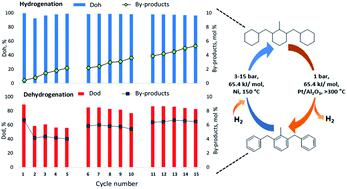当前位置:
X-MOL 学术
›
Sustain. Energy Fuels
›
论文详情
Our official English website, www.x-mol.net, welcomes your
feedback! (Note: you will need to create a separate account there.)
Stress tolerance assessment of dibenzyltoluene-based liquid organic hydrogen carriers
Sustainable Energy & Fuels ( IF 5.0 ) Pub Date : 2020-07-01 , DOI: 10.1039/d0se00625d Phillimon Modisha 1, 2, 3, 4 , Dmitri Bessarabov 1, 2, 3, 4
Sustainable Energy & Fuels ( IF 5.0 ) Pub Date : 2020-07-01 , DOI: 10.1039/d0se00625d Phillimon Modisha 1, 2, 3, 4 , Dmitri Bessarabov 1, 2, 3, 4
Affiliation

|
Hydrogen production from charged liquid organic hydrogen carrier (LOHC) systems is always a trade-off between the molecule's storage capacity and the stability over the numerous charging/discharging cycles. This is because deep dehydrogenation induces cracking of the molecule and thus the storage capacity could be compromised by partial dehydrogenation. It is crucial to optimize a hydrogenation system in order to avoid possible excessive exothermic temperature whilst maintaining a high degree of hydrogenation (doh). Pure dibenzyltoluene (H0-DBT) was hydrogenated up to 98% at a relatively low pressure of 15 barg (instead of at the frequently used 30–50 barg). We determined the number of cycles that a LOHC molecule can tolerate from the amount of by-products produced during each hydrogen charge/discharge cycle. If a limit of by-products is low such as in the case of toxic compounds if available, the LOHC duration of use will be short. A higher limit for LOHC based by-products suggests a long duration of usage. Furthermore, in the absence of any by-products, the LOHC molecule usage could be endless. This certainly depends on operating conditions, catalyst type and metal loading used. Accelerated stress tests were used to predict the time to failure of the LOHC molecule. Methane was obtained in the gas phase and the liquid by-products follow the increasing order: benzene < C21 < xylene < C13–C15 < toluene < H0-MBT. Indications were that the dibenzyltoluene based LOHC is quite stable because the amount of liquid by-products obtained under stress conditions is 7.4 mol%.
中文翻译:

二苄基甲苯基液态有机氢载体的耐应力评估
从带电的液态有机氢载体(LOHC)系统产生的氢始终是分子在众多充电/放电循环中的存储容量和稳定性之间的权衡。这是因为深度脱氢引起分子裂解,因此部分脱氢可能损害储存能力。优化加氢系统至关重要,以避免在保持高氢化度(doh)的同时可能出现过高的放热温度。纯二苄基甲苯(H0-DBT)在相对较低的15 barg(而不是经常使用的30-50 barg)压力下氢化至98%。我们从每个氢充/放电周期中产生的副产物的数量确定了LOHC分子可以耐受的周期数。如果副产物的限量较低(例如在有毒化合物的情况下),则LOHC的使用期限将很短。基于LOHC的副产品的上限较高,表明使用期限较长。此外,在没有任何副产物的情况下,LOHC分子的使用可能是无限的。这当然取决于操作条件,催化剂类型和所使用的金属负载量。加速应力测试用于预测LOHC分子失效的时间。在气相中获得甲烷,而液体副产物按增加顺序排列:苯<C21 <二甲苯<C13–C15 <甲苯<H0-MBT。指示基于二苄基甲苯的LOHC非常稳定,因为在应力条件下获得的液体副产物的量为7.4mol%。LOHC的使用期限将很短。基于LOHC的副产品的上限较高,表明使用期限较长。此外,在没有任何副产物的情况下,LOHC分子的使用可能是无限的。这当然取决于操作条件,催化剂类型和所使用的金属负载量。加速应力测试用于预测LOHC分子失效的时间。在气相中获得甲烷,而液体副产物按增加顺序排列:苯<C21 <二甲苯<C13–C15 <甲苯<H0-MBT。表明基于二苄基甲苯的LOHC非常稳定,因为在压力条件下获得的液体副产物的量为7.4mol%。LOHC的使用期限将很短。基于LOHC的副产品的上限较高,表明使用期限较长。此外,在没有任何副产物的情况下,LOHC分子的使用可能是无限的。这当然取决于操作条件,催化剂类型和所使用的金属负载量。加速应力测试用于预测LOHC分子失效的时间。在气相中获得甲烷,而液体副产物按增加顺序排列:苯<C21 <二甲苯<C13–C15 <甲苯<H0-MBT。表明基于二苄基甲苯的LOHC非常稳定,因为在压力条件下获得的液体副产物的量为7.4mol%。LOHC分子的用途可能是无限的。这当然取决于操作条件,催化剂类型和所使用的金属负载量。加速应力测试用于预测LOHC分子失效的时间。在气相中获得甲烷,而液体副产物则按增加的顺序排列:苯<C21 <二甲苯<C13-C15 <甲苯<H0-MBT。表明基于二苄基甲苯的LOHC非常稳定,因为在压力条件下获得的液体副产物的量为7.4mol%。LOHC分子的用途可能是无限的。这当然取决于操作条件,催化剂类型和所使用的金属负载量。加速应力测试用于预测LOHC分子失效的时间。在气相中获得甲烷,而液体副产物按升序排列:苯<C21 <二甲苯<C13-C15 <甲苯<H0-MBT。表明基于二苄基甲苯的LOHC非常稳定,因为在压力条件下获得的液体副产物的量为7.4mol%。C13–C15 <甲苯<H0-MBT。表明基于二苄基甲苯的LOHC非常稳定,因为在压力条件下获得的液体副产物的量为7.4mol%。C13–C15 <甲苯<H0-MBT。表明基于二苄基甲苯的LOHC非常稳定,因为在压力条件下获得的液体副产物的量为7.4mol%。
更新日期:2020-08-25
中文翻译:

二苄基甲苯基液态有机氢载体的耐应力评估
从带电的液态有机氢载体(LOHC)系统产生的氢始终是分子在众多充电/放电循环中的存储容量和稳定性之间的权衡。这是因为深度脱氢引起分子裂解,因此部分脱氢可能损害储存能力。优化加氢系统至关重要,以避免在保持高氢化度(doh)的同时可能出现过高的放热温度。纯二苄基甲苯(H0-DBT)在相对较低的15 barg(而不是经常使用的30-50 barg)压力下氢化至98%。我们从每个氢充/放电周期中产生的副产物的数量确定了LOHC分子可以耐受的周期数。如果副产物的限量较低(例如在有毒化合物的情况下),则LOHC的使用期限将很短。基于LOHC的副产品的上限较高,表明使用期限较长。此外,在没有任何副产物的情况下,LOHC分子的使用可能是无限的。这当然取决于操作条件,催化剂类型和所使用的金属负载量。加速应力测试用于预测LOHC分子失效的时间。在气相中获得甲烷,而液体副产物按增加顺序排列:苯<C21 <二甲苯<C13–C15 <甲苯<H0-MBT。指示基于二苄基甲苯的LOHC非常稳定,因为在应力条件下获得的液体副产物的量为7.4mol%。LOHC的使用期限将很短。基于LOHC的副产品的上限较高,表明使用期限较长。此外,在没有任何副产物的情况下,LOHC分子的使用可能是无限的。这当然取决于操作条件,催化剂类型和所使用的金属负载量。加速应力测试用于预测LOHC分子失效的时间。在气相中获得甲烷,而液体副产物按增加顺序排列:苯<C21 <二甲苯<C13–C15 <甲苯<H0-MBT。表明基于二苄基甲苯的LOHC非常稳定,因为在压力条件下获得的液体副产物的量为7.4mol%。LOHC的使用期限将很短。基于LOHC的副产品的上限较高,表明使用期限较长。此外,在没有任何副产物的情况下,LOHC分子的使用可能是无限的。这当然取决于操作条件,催化剂类型和所使用的金属负载量。加速应力测试用于预测LOHC分子失效的时间。在气相中获得甲烷,而液体副产物按增加顺序排列:苯<C21 <二甲苯<C13–C15 <甲苯<H0-MBT。表明基于二苄基甲苯的LOHC非常稳定,因为在压力条件下获得的液体副产物的量为7.4mol%。LOHC分子的用途可能是无限的。这当然取决于操作条件,催化剂类型和所使用的金属负载量。加速应力测试用于预测LOHC分子失效的时间。在气相中获得甲烷,而液体副产物则按增加的顺序排列:苯<C21 <二甲苯<C13-C15 <甲苯<H0-MBT。表明基于二苄基甲苯的LOHC非常稳定,因为在压力条件下获得的液体副产物的量为7.4mol%。LOHC分子的用途可能是无限的。这当然取决于操作条件,催化剂类型和所使用的金属负载量。加速应力测试用于预测LOHC分子失效的时间。在气相中获得甲烷,而液体副产物按升序排列:苯<C21 <二甲苯<C13-C15 <甲苯<H0-MBT。表明基于二苄基甲苯的LOHC非常稳定,因为在压力条件下获得的液体副产物的量为7.4mol%。C13–C15 <甲苯<H0-MBT。表明基于二苄基甲苯的LOHC非常稳定,因为在压力条件下获得的液体副产物的量为7.4mol%。C13–C15 <甲苯<H0-MBT。表明基于二苄基甲苯的LOHC非常稳定,因为在压力条件下获得的液体副产物的量为7.4mol%。











































 京公网安备 11010802027423号
京公网安备 11010802027423号